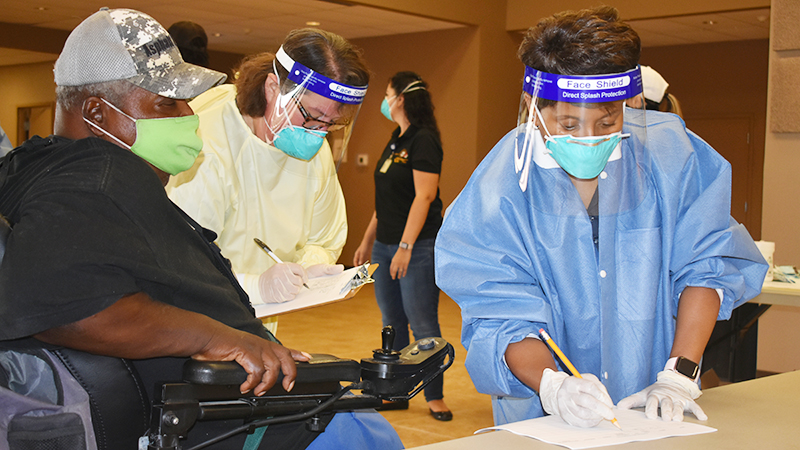Jefferson County’s COVID-19 threat level hits Red amid welcoming news on vaccine possibility
Published 12:28 am Tuesday, November 10, 2020

- Kevin Dennis, left, gives information to Port Arthur Health Director Judith Smith, right, and Karla Quigley, nurse supervisor inside the Bob Bowers Civic Center in August of 2020.
|
Getting your Trinity Audio player ready...
|
Monday’s news that pharmaceutical company Pfizer and biopharmaceutical firm BioNTech announced a 90 percent efficacy rate of its vaccine candidate may have given millions hope of a solution to the pandemic, but the director of the Port Arthur Health Department cautioned basic measures against COVID-19 — such as wearing masks and social distancing —still need to be followed “for a while.”
The medical news comes, however, as Jefferson County’s COVID-19 threat level has elevated to Red based on the increase of the 14-day average.
“We’ve had some decreases, but we’re starting to see some increases,” PAHD Director Judith Smith said.
The 14-day average for the service area — Port Arthur, Nederland, Port Neches and Groves — has fluctuated between 10 and 22 since Sept. 13, but has not been higher than 25 since early August, according to charts provided by Jefferson County Judge Jeff Branick.
Smith said she’s sat in on webinars from the Department of State Health Services addressing vaccine distribution. Federal officials have yet to approve the vaccine.
Pfizer and BioNTech said in its joint statement its submission for Emergency Use Authorization to the Food and Drug Administration is planned for “soon after the required safety milestone is achieved, which is currently expected to occur in the third week of November.”
They added “no serious safety concerns have been observed” in a Phase 3 study of 43,538 participants, 42 percent of whom have “diverse backgrounds.” The analysis evaluated 94 confirmed COVID-19 cases in trial participants, it added.
“We are reaching this critical milestone in our vaccine development program at a time when the world needs it most with infection rates setting new records, hospitals nearing over-capacity and economies struggling to reopen,” Pfizer Chairman and CEO Dr. Albert Bourla said in a news release.
The COVID-19 hospitalization rate in Jefferson County is at 10 percent.
Smith said when distribution of a vaccine begins, it would be “orderly.” But a timeline for that is hard to establish, she added.
“I’m not sure at what stage it’ll be open to the public,” she said. “They’ll target first responders first.”
According to the Nov. 6 daily report from Branick, the county saw 323 new cases of the virus, taking the 14-day average from 33.8 to 40.6. The rate on Oct. 26 was 30.4, which left the county in an Orange threat level because there was little to no change in the average.
For the PAHD region, the daily total reached 40 on Nov. 4, its highest since reaching 45 on Oct. 28. That number had not exceeded 30 since Oct. 19.
The PAHD is seeing more families impacted by coronavirus amid changes in the weather, Smith said.
“When one person is in the house, it’s more families that are being reported,” she said. “That seems to be why our numbers have been increasing in the last few days. It’s more in the household. We’re still having some gatherings. Even though it may not be many, it’s a lot of people comfortable with others coming in the home, not socially distancing and not wearing a mask.”
The Department of State Health Services, according to its vaccination plan, referred to its post-action evaluation of the 2009 H1N1 pandemic in determining a public-private partnership would be the best distribution model for a COVID-19 vaccine.
Once the FDA approves a vaccine, Texas health officials would distribute it in phases, Smith said.
“Of course, we want the vaccine to be a good reliable vaccine,” Smith said. “I think it’ll be beneficial once we know it’s reliable and the community knows it’s reliable. I think there’s a lot of hesitancy in the community. People are going to be very concerned more so about the adverse reactions.”
The majority of those Smith asked about taking such a vaccine have said either “no” or “I’m not sure,” she said. Asked if she’d take the vaccine, she responded: “Absolutely, I would take it if I know it’s beneficial.”
She continued: “Do the benefits outweigh the risk? We won’t know, but how did they know when they came up with childhood vaccines? I understand people’s fears because it’s so new. I take it by faith.”






